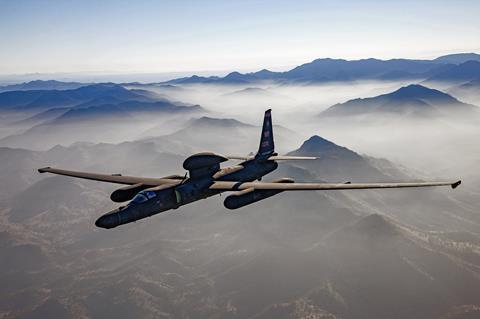While the US Department of Defense (DoD) is largely keeping quiet about what measures it took during the recent flyover of a Chinese surveillance balloon, American diplomats have revealed new details.
Those include flights by multiple Lockheed Martin U-2 high-altitude surveillance aircraft to monitor the balloon during its transit of US airspace.

Speaking on 9 February, a senior official with US Department of State who is familiar with the topic reveals U-2 flights were crucial in supporting Washington’s conclusion of the balloon being an intelligence-gathering platform.
“High-resolution imagery from U-2 flybys revealed that the high-altitude balloon was capable of conducting signals intelligence collection operations,” says the official, who is not being identified due to the sensitive nature of the subject.
Details of the balloon’s structure, including the presence of communications antennas and power-generating solar panels were among the information confirmed by U-2 flights.
The U-2 “routinely” flies at altitudes above 70,000ft, according to the US Air Force (USAF), which operates 27 of the jets. At such heights, the service says its pilots wear astronaut-like full-body pressure suits.
That, combined with the type’s bicycle-style gear and handling characteristics at lower altitudes, leads the USAF to describe the U-2 as “the most difficult aircraft in the world to fly”.
Notably, the craft’s lofty operational ceiling allowed the U-2 to fly at the same level as the Chinese surveillance balloon, which was last reported by the DoD between 60,000ft and 65,000ft.
The USAF says its U-2s can be fitted with a range of sensor packages, including an electro-optical/infrared camera, optical bar camera, advanced synthetic aperture radar, signals intelligence and network-centric communication.
Signals intelligence gathered by a U-2 can be transmitted in “near real-time anywhere in the world”, the USAF says, via air-to-ground or air-to-satellite data links.
An upgrade and modernisation programme for the type also “provided a complete redesign of the cockpit with digital colour multifunction displays and up-front avionics controls to replace the 1960s-vintage round dial gauges, which were no longer supportable”, according to the service.
The U-2 is powered by a General Electric F118-101 engine, which the USAF describes as “lightweight, fuel efficient” and negating of the need for air refuelling on long duration missions.
Normally, the US military is not legally authorised to conduct intelligence-gathering operations on domestic territory. DoD officials – including the head of US Northern Command, which led the response – say they were given special approval to use surveillance platforms, such as the U-2 and Boeing RC-135 Rivet Joint jet, to monitor the balloon within US airspace.
“Specific authorities were granted to collect intelligence against the balloon,” says USAF General Glen VanHerck.
That craft was ultimately shot down off the coast of South Carolina by a USAF Lockheed F-22 fighter on 4 February.
The Department of State also says it has determined the manufacturer of the downed airship. The government claims that company is connected to China’s armed forces, officially known as the People’s Liberation Army (PLA).
“We are confident that the balloon manufacturer has a direct relationship with China’s military and is an approved vendor of the PLA, according to information published in an official procurement portal for the PLA,” the Department of State official says.
Department of State representative Ned Price on 9 February said Washington now believes Beijing’s balloon programme has “spanned five continents, 40 countries and… deployed these types of assets around the globe”.
Currently, the USA is not seeking to organise any “formal coalition” of countries suspected of being targeted for balloon surveillance, according to Price.
However, he says Washington is instead seeking to have “a convergence of views” regarding the challenges presented by China and its geopolitical activities.
Beijing initially apologised for the encroaching into US airspace, but continues to deny the balloon was intended for military or intelligence purposes, instead calling it a tool for collecting weather data.



















